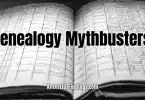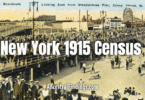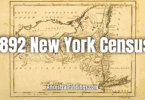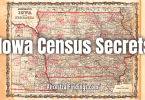The 1820 U.S. Census rolled out during what historians often call the “Era of Good Feelings”—a peaceful name for a time that was anything but simple. The War of 1812 had ended just a few years earlier. James Monroe was president, and the country was pushing its borders westward at full speed. Tensions over slavery, expansion, and power were beginning to heat up, even though the surface looked calm.
The 1820 census is a small turning point for those tracing family histories. It’s still far from perfect—only the head of household is named—but it gives us more than the earlier counts. And if you know how to read between the lines and pair it with other records, it can open up many doors.
A Country Stretching West
By 1820, the United States had grown to 23 states, up from 17 just a decade earlier. Five new states had joined since the last census: Louisiana (1812), Indiana (1816), Mississippi (1817), Illinois (1818), and Alabama (1819). The frontier was pulling people west, and the federal government was trying to keep up—offering land, tracking settlers, and gathering information to shape the future.
That growth meant more names to count, more places to cover, and more detail needed. The 1820 census introduced new categories and questions to help meet those needs.
What They Asked—and Why It Matters
The 1820 census still didn’t name everyone in the household, but expanded what was collected. For each household, census takers recorded:
- The name of the head of household
- Number of free white males and females by age group
- Number of enslaved individuals, now broken down by age
- Number of other free persons (including free Black and Native American individuals living outside tribal lands)
- Number of foreigners not naturalized
- The number of people involved in agriculture, commerce, or manufacturing
That last part is what makes this census stand out. For the first time, we’re told how people earned a living—or at least what general field they worked in. Suppose your ancestor was a farmer; that shows up. If they were involved in trade or making goods, that’s noted too. It’s not specific, but it gives you something to work with.
The question about foreigners not naturalized is another telling detail. It shows that the government was starting to track immigration more intentionally, keeping an eye on those who hadn’t yet become U.S. citizens. That clue can lead you to naturalization or passenger records if you’re tracking down someone who may have arrived shortly before 1820.
What Was Going On Behind the Scenes
While this census was being taken, the country was tangled in one of the biggest political arguments of the early 1800s: the Missouri Compromise. Missouri wanted to enter the Union as a slave state. That sparked a national fight over whether new states should allow slavery—and how power would be divided between free and slave states.
Why does this relate to the census? Population numbers determine how many representatives each state has in Congress. That’s why the census kept such close track of enslaved individuals. The more people a state counted—free or enslaved—the more influence it had.
The census wasn’t just about headcounts. It shaped the balance of political power, the direction of lawmaking, and how quickly new states would be admitted. For a researcher, it’s a reminder that behind every column of numbers, decisions were being made that affected entire generations.
Who Did the Counting?
Like earlier censuses, this one was carried out by U.S. marshals and their assistants. But for the first time, they were given printed forms to fill out instead of having to draw up their columns. That brought more consistency, but the accuracy still depended on the person doing the work.
If you’ve ever read through an 1820 census page and thought the handwriting looked rushed or the numbers didn’t quite line up, you’re not imagining it. Census takers often covered long distances with little oversight. Some did careful, detailed work. Others didn’t.
It’s also worth remembering that families weren’t always home—or weren’t always cooperative. Some were missed. Others were counted under neighbors’ descriptions or vague memories. It’s part of the challenge (and the charm) of working with early records.
Using the 1820 Census to Build a Bigger Picture
The 1820 census provides a helpful snapshot, but if you want to really understand your ancestors during this time, you need to pair that snapshot with other records—especially land deeds, court documents, and military files. That’s how I usually find the pieces that make everything click.
Land was a major force behind the census that year. People were moving into new territories by the thousands. If your ancestor appears in Indiana, Illinois, Mississippi, Alabama, or Louisiana in 1820, there’s a good chance they were part of that westward movement. That often means they left behind a paper trail in the form of land patents. I usually start with the Bureau of Land Management’s land patent database. It’s helped me confirm where families settled, how many acres they claimed, and when they arrived. If the 1820 census says someone was working in agriculture, seeing their land purchased right around the same time gives you a stronger sense of their life.
Once I know where they were, I head to the county court records. These are full of clues, especially in places where the census doesn’t give enough detail. Deeds can tell me who sold or received land and whether it was passed down through the family. Probate files often name children, grandchildren, and even in-laws. A marriage record or court document can sometimes explain if a child seems to disappear between 1810 and 1820. When I don’t see someone in the census but find them in the tax rolls, I ask whether they were missed by the census taker or just passed through.
I also pay attention to movement. When a family shows up in a new place in 1820, I try to figure out how they got there. Many traveled along known migration paths—like the Wilderness Road from Virginia through Kentucky and into Tennessee, or the National Road that stretched from Maryland through Ohio and into Indiana. Some families moved as a group—brothers, cousins, or even entire church communities. I look closer if I see familiar names clustered together on the census. That kind of movement often points to shared roots.
Then there’s the occupation column. That stands out if someone in the census is listed under commerce or manufacturing, especially in an area where most folks were farming. It tells me this person may have been running a shop, working as a blacksmith, making furniture, or dealing in trade. That opens up a different kind of research path. I start looking for business licenses, newspaper ads, and mentions in local histories. Sometimes, those little clues explain why someone didn’t own much land—their work was tied to goods or services, not farming.
And finally, I don’t ignore military records—especially if the head of household was in his late twenties to mid-forties during this time. Many men who served in the War of 1812 received land as payment or later applied for pensions. Those files often include service dates, names of spouses and children, and even firsthand accounts from neighbors or relatives. They’ve helped me figure out why someone suddenly appears in Missouri or Arkansas, even though I couldn’t find them in earlier records. Sometimes it was a land bounty that brought them west.
The 1820 census on its own doesn’t tell you everything. But when you use it as a guide—and line it up with land, court, and military records—you start seeing the whole shape of someone’s life. That’s when it gets really interesting.






